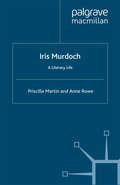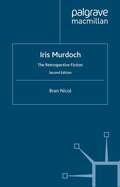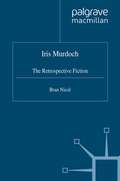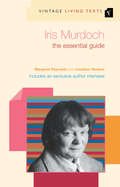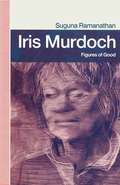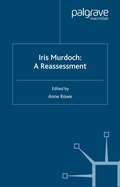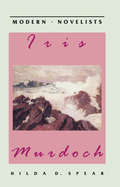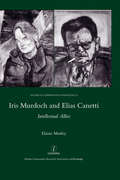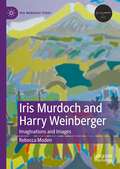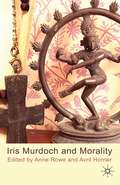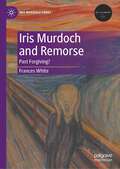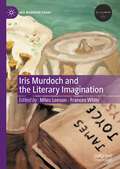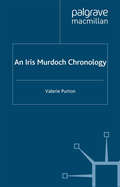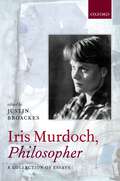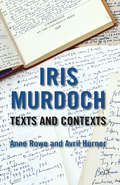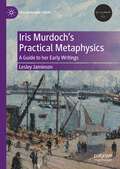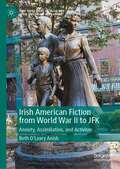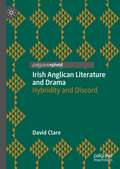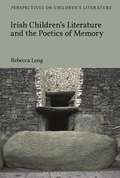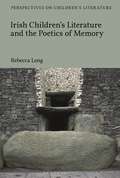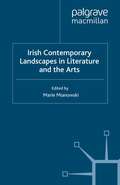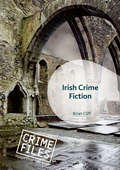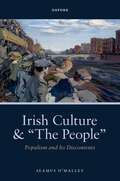- Table View
- List View
Iris Murdoch: A Literary Life (Literary Lives)
by P. Martin Anne RoweThis largely chronological study of Iris Murdoch's literary life begins with her fledgling publications at Badminton School and Oxford, and her Irish heritage. It moves through the novels of the next four decades and concludes with an account of the biographical, critical and media attention given to her life and work since her death in 1999.
Iris Murdoch: The Retrospective Fiction
by B. NicolIris Murdoch: The Retrospective Fiction traces the preoccupation in Murdoch's fiction with the way the past makes its mark upon us, haunting us and eluding our attempts to grasp it. This argument was given an extra resonance by the death of Murdoch after Alzheimer's disease in 1999, when the book was first published - a curious blurring of life and work typical of the posthumous reassessment of Murdoch. This new edition includes detailed readings of novels not discussed in the original ( The Bell, The Sacred and Profane Love Machine , and The Philosopher's Pupil ) and includes a new preface, an updated bibliography and three new chapters covering Murdoch's most important and popular novels, considering in more depth her relationship with the dominant literary and intellectual currents of her time.
Iris Murdoch: The Retrospective Fiction
by B. NicolIris Murdoch: The Retrospective Fiction considers one of the major British novelists of the post-war years in a new light, arguing that Murdoch's compulsive plots and characters are strongly motivated by the question of the past. Drawing on many of her key works, and providing the first analysis of her 'first-person retrospective' novels as a separate group within the larger body of her fiction, the book also considers Murdoch's relation to key currents within twentieth-century thought, like modernism. postmodernism, and psychoanalysis.
Iris Murdoch: The Essential Guide (Vintage Living Texts #2)
by Jonathan Noakes Margaret ReynoldsIn Vintage Living Texts, teachers, students and any lover of literature will find the essential guide to the major works of Iris Murdoch. Iris Murdoch's themes, genre and narrative techniques are put under scrutiny and the emphasis is on providing a rich source of ideas for intelligent and inventive ways of approaching the novels. Amongst many other features you'll find inspirational reading plans and contextual material, suggested complementary and comparative reading and an indispensable glossary. Featured texts: The Black Prince, The Sea, The Sea, The Bell'I didn't realise just how good the series was until I started working closely with it. The questions are so thoughtful and probing-the texts really do occupy their own niche between guides purely for teachers and the ubiquitous student crib, and are much better than either' Head of English, Newington College, Australia
Iris Murdoch: A Reassessment
by A. RoweThis book is an eclectic mix of essays that reposition Murdoch's work in relation to current debates in philosophy, theology, literature, gender and sexuality, and authorship. The essays refine, develop or contest previous readings, and blur the distinction between liberal humanist and theoretical positions, suggesting negotiations between them.
Iris Murdoch
by Hilda D. SpearThis book attempts to offer a critical survey of the fiction of one of our most prolific living novelists. After giving a short account of Murdoch's life and work, it goes on to look at the novels themselves, dividing them into chronological periods and suggesting parallels between them and the progress of Murdoch's philosophic thought.
Iris Murdoch and Elias Canetti: Intellectual Allies
by Elaine Morley"Since the revelation of Iris Murdoch's (1919-1999) affair with Elias Canetti (1905-1994), scholarship on their relationship has been largely biographical, focusing in particular on Canetti's alleged role as the real-life model for some of Murdoch's most invidious protagonists. Little research, however, has been done on the extensive common ground between the two writers' literary projects. In this groundbreaking comparative study, Elaine Morley conducts a careful philological comparison of Murdoch's and Canetti's works, from their literary themes and theories to their idiosyncratic stylistic practices. Morley demonstrates that these authors were preoccupied with a common philosophical problem, and that they were in fact not only personally close, but also more intellectually allied than has been previously thought. Elaine Morley is Lecturer in German and Comparative Literature at Queen Mary, University of London where she convenes the MA in Anglo-German Cultural Relations."
Iris Murdoch and Elias Canetti: Intellectual Allies
by Elaine Morley"Since the revelation of Iris Murdoch's (1919-1999) affair with Elias Canetti (1905-1994), scholarship on their relationship has been largely biographical, focusing in particular on Canetti's alleged role as the real-life model for some of Murdoch's most invidious protagonists. Little research, however, has been done on the extensive common ground between the two writers' literary projects. In this groundbreaking comparative study, Elaine Morley conducts a careful philological comparison of Murdoch's and Canetti's works, from their literary themes and theories to their idiosyncratic stylistic practices. Morley demonstrates that these authors were preoccupied with a common philosophical problem, and that they were in fact not only personally close, but also more intellectually allied than has been previously thought. Elaine Morley is Lecturer in German and Comparative Literature at Queen Mary, University of London where she convenes the MA in Anglo-German Cultural Relations."
Iris Murdoch and Harry Weinberger: Imaginations and Images (Iris Murdoch Today)
by Rebecca ModenThe novelist and philosopher Iris Murdoch and the painter Harry Weinberger engaged in over twenty years of close friendship and intellectual discourse, centred on sustained discussion of the practice, teaching and morality of art. This book presents a reappraisal of Murdoch’s novels – chiefly, three mature novels, The Sea, The Sea (1978), Nuns and Soldiers (1980) and The Good Apprentice (1985), and two enigmatic late novels, The Green Knight (1993) and Jackson’s Dilemma (1995) – which are perceived through the prism of her discourse with Weinberger. It draws on a run of almost 400 letters from Murdoch to Weinberger, and on Murdoch’s philosophical writings, Weinberger’s private writings, the remarks of both artists in interviews, and other material relating to their views on art and art history, much of which is unpublished and has received no previous critical attention. Scrutiny of their shared values, methods and the imagistic dialogue that takes place in their art provides original perspectives on Murdoch’s creativity, and new ways of understanding her experimentation with the visual arts. This book offers a new line of enquiry into Murdoch's novels, and into the relationship between literature and the visual arts.
Iris Murdoch and Morality
by Anne RoweIris Murdoch and Morality provides a close focus on moral issues in Murdoch's novels, philosophy and theology. It situates Murdoch within current theoretical debates and develops an understanding of her work as a crucial link between twentieth and twenty-first century writing and theory.
Iris Murdoch and Remorse: Past Forgiving? (Iris Murdoch Today)
by Frances WhiteThis exploration of the crucially important role played by remorse in Iris Murdoch’s philosophical, theological, and political thinking identifies it as a critical concept in her moral psychology and a recurrent theme in her art. Through engagement with Simone Weil, current theories of remorse, trauma theory and Holocaust studies, it offers fresh perspectives on Murdoch’s fiction – particularly the late novels, her radio play The One Alone, and her monograph Heidegger.
Iris Murdoch and the Literary Imagination (Iris Murdoch Today)
by Miles Leeson Frances WhiteThis volume is the third volume in Palgrave' Macmillan's new Iris Murdoch Today scholarly series.Iris Murdoch and the Literary Imagination is the first major collection of literary essays since her centenary in 2019. It brings together leading Murdoch scholars from across the world who expand the boundaries of recent criticism offering work not only on the novels, but on her unpublished poetry and archival materials. This collection discusses her interest in, and use of, Japanese literature; her relationship with, and reader-response to her, in Australia; Murdoch in the post #metoo era; her lifelong interest in the supernatural, same-sex relationships and friendships; as well as the use and abuse of biographical material. The collection widens the field of Murdoch studies and marks a new waypoint in the development of her critical reception.
An Iris Murdoch Chronology (Author Chronologies Series)
by V. PurtonIris Murdoch was the author of twenty-six bestselling novels. Her many love affairs, her war-work with UNRRA, her move from early communism to Thatcherism, her later life as a secular saint, her sad decline from Alzheimer's - all these events are detailed in this accessible chronological account of a world-famous and much loved British writer.
Iris Murdoch, Philosopher
by Justin BroackesIris Murdoch was a notable philosopher before she was a notable novelist and her work was brave, brilliant, and independent. She made her name first for her challenges to Gilbert Ryle and behaviourism, and later for her book on Sartre (1953), but she had the greatest impact with her work in moral philosophy—and especially her book The Sovereignty of Good (1970). She turned expectantly from British linguistic philosophy to continental existentialism, but was dissatisfied there too; she devised a philosophy and a style of philosophy that were distinctively her own. Murdoch aimed to draw out the implications, for metaphysics and the conception of the world, of rejecting the standard dichotomy of language into the 'descriptive' and the 'emotive'. She aimed, in Wittgensteinian spirit, to describe the phenomena of moral thinking more accurately than the 'linguistic behaviourists' like R. M. Hare. This 'empiricist' task could be acheived, Murdoch thought, only with help from the idealist tradition of Kant, Hegel, and Bradley. And she combined with this a moral psychology, or theory of motivation, that went back to Plato, but was influenced by Freud and Simone Weil. Murdoch's impact can be seen in the moral philosophy of John McDowell and, in different ways, in Richard Rorty and Charles Taylor, as well as in the recent movements under the headings of moral realism, particularism, moral perception, and virtue theory. This volume brings together essays by critics and admirers of Murdoch's work, and includes a longer Introduction on Murdoch's career, reception, and achievement. It also contains a previously unpublished chapter from the book on Heidegger that Murdoch had been working on shortly before her death, and a Memoir by her husband John Bayley. It gives not only an introduction to Murdoch's important philosophical life and work, but also a picture of British philosophy in one of its heydays and at an important moment of transition.
Iris Murdoch: Texts and Contexts
by Anne Rowe and Avril HornerUsing unpublished archive material, including correspondence and the many annotations Murdoch made to the books held in her Oxford library, this book offers fresh insights into Murdoch's work by placing it within a diversity of new contexts. It also reveals startling parallels between Murdoch's work and other literary and philosophical texts.
Iris Murdoch’s Practical Metaphysics: A Guide to her Early Writings (Iris Murdoch Today)
by Lesley JamiesonThis book explores Iris Murdoch as a philosopher who, through her distinctive methodology, exploits the advantages of having a mind on the borders of literature and politics in her early career writings (pre-The Sovereignty of Good). By focusing on a single decade of Murdoch’s early career, Jamieson tracks connections between her views on the state of literature and politics in postwar Britain and her approach to the philosophy of mind and moral philosophy. Furthermore, this close study reveals that, far from a stylistic quirk, Murdoch’s use of metaphors, analogies, and other literary devices is internal to her methodology. Finally, rather than asking what Murdoch’s views are, this work will ask “what is Murdoch trying to achieve with her writings and public lectures, and how does she go about this?” By answering the latter question, we will have a new strategy for interpreting her writings more generally. The book contributes to the growing body of scholarship focusing on Iris Murdoch’s philosophical writings, and on women in the history of analytic philosophy.
Irish American Fiction from World War II to JFK: Anxiety, Assimilation, and Activism (New Directions in Irish and Irish American Literature)
by Beth O’Leary AnishIrish American Fiction from World War II to JFK addresses the concerns of Irish America in the post-war era by studying its fiction and the authors who brought the communities of their youth to life on the page. With few exceptions, the novels studied here are lesser-known works, with little written about them to date. Mining these tremendous resources for the details of Irish American life, this book looks back to the beginning of the twentieth century, when the authors' immigrant grandparents were central to their communities. It also points forward to the twenty-first century, as the concerns these authors had for the future of Irish America have become a legacy we must grapple with in the present.
Irish Anglican Literature and Drama: Hybridity and Discord
by David ClareThis book discusses key works by important writers from Church of Ireland backgrounds (from Farquhar and Swift to Beckett and Bardwell), in order to demonstrate that writers from this Irish subculture have a unique socio-political viewpoint which is imperfectly understood. The Anglican Ascendancy was historically referred to as a “middle nation” between Ireland and Britain, and this book is an examination of the various ways in which Irish Anglican writers have signalled their Irish/British hybridity. “British” elements in their work are pointed out, but so are manifestations of their proud Irishness and what Elizabeth Bowen called her community’s “subtle … anti-Englishness.” Crucially, this book discusses several writers often excluded from the “truly” Irish canon, including (among others) Laurence Sterne, Elizabeth Griffith, and C.S. Lewis.
Irish Children’s Literature and the Poetics of Memory (Bloomsbury Perspectives on Children's Literature)
by Rebecca LongFocusing on the mythological narratives that influence Irish children's literature, this book examines the connections between landscape, time and identity, positing that myth and the language of myth offer authors and readers the opportunity to engage with Ireland's culture and heritage. It explores the recurring patterns of Irish mythological narratives that influence literature produced for children in Ireland between the nineteenth and the twenty-first centuries. A selection of children's books published between 1892, when there was an escalation of the cultural pursuit of Irish independence and 2016, which marked the centenary of the Easter 1916 rebellion against English rule, are discussed with the aim of demonstrating the development of a pattern of retrieving, re-telling, remembering and re-imagining myths in Irish children's literature. In doing so, it examines the reciprocity that exists between imagination, memory, and childhood experiences in this body of work.
Irish Children’s Literature and the Poetics of Memory (Bloomsbury Perspectives on Children's Literature)
by Rebecca LongFocusing on the mythological narratives that influence Irish children's literature, this book examines the connections between landscape, time and identity, positing that myth and the language of myth offer authors and readers the opportunity to engage with Ireland's culture and heritage. It explores the recurring patterns of Irish mythological narratives that influence literature produced for children in Ireland between the nineteenth and the twenty-first centuries. A selection of children's books published between 1892, when there was an escalation of the cultural pursuit of Irish independence and 2016, which marked the centenary of the Easter 1916 rebellion against English rule, are discussed with the aim of demonstrating the development of a pattern of retrieving, re-telling, remembering and re-imagining myths in Irish children's literature. In doing so, it examines the reciprocity that exists between imagination, memory, and childhood experiences in this body of work.
Irish Contemporary Landscapes in Literature and the Arts
by Marie MianowskiLooking at representations of the Irish landscape in contemporary literature and the arts, this volume discusses the economic, political and environmental issues associated with it, questioning the myths behind Ireland's landscape, from the first Greek descriptions to present day post Celtic-Tiger architecture.
Irish Crime Fiction (Crime Files)
by Brian CliffThis book examines the recent expansion of Ireland's literary tradition to include home-grown crime fiction. It surveys the wave of books that use genre structures to explore specifically Irish issues such as the Troubles and the rise and fall of the Celtic Tiger, as well as Irish experiences of human trafficking, the supernatural, abortion, and civic corruption. These novels are as likely to address the national regulation of sexuality through institutions like the Magdalen Laundries as they are to follow serial killers through the American South or to trace international corporate conspiracies.This study includes chapters on Northern Irish crime fiction, novels set in the Republic, women protagonists, and transnational themes, and discusses Irish authors’ adaptations of a well-loved genre and their effect on assumptions about the nature of Irish literature. It is a book for readers of crime fiction and Irish literature alike, illuminating the fertile intersections of the two.
Irish Culture and “The People”: Populism and its Discontents
by Seamus O'MalleyThis book argues that populism has been a shaping force in Irish literary culture. Populist moments and movements have compelled authors to reject established forms and invent new ones. Sometimes, as in the middle period of W.B. Yeats's work, populism forces a writer into impossible stances, spurring ever greater rhetorical and poetic creativity. At other times, as in the critiques of Anna Parnell or Myles na gCopaleen, authors penetrate the rhetoric fog of populist discourse and expose the hollowness of its claims. Yet in both politics and culture, populism can be a generative force. Daniel O'Connell, and later the Land League, utilized populist discourse to advance Irish political freedom and expand rights. The most powerful works of Lady Gregory and Ernie O'Malley are their portraits of The People that borrows from the populist vocabulary. While we must be critical of populist discourse, we dismiss it at our loss. This study synthesizes existing scholarship on populism to explore how Irish texts have evoked "The People"—a crucial rhetorical move for populist discourse—and how some writers have critiqued, adopted, and adapted the languages of Irish populisms.
Irish Culture and The People: Populism and its Discontents
by Seamus O'MalleyThis book argues that populism has been a shaping force in Irish literary culture. Populist moments and movements have compelled authors to reject established forms and invent new ones. Sometimes, as in the middle period of W.B. Yeats's work, populism forces a writer into impossible stances, spurring ever greater rhetorical and poetic creativity. At other times, as in the critiques of Anna Parnell or Myles na gCopaleen, authors penetrate the rhetoric fog of populist discourse and expose the hollowness of its claims. Yet in both politics and culture, populism can be a generative force. Daniel O'Connell, and later the Land League, utilized populist discourse to advance Irish political freedom and expand rights. The most powerful works of Lady Gregory and Ernie O'Malley are their portraits of The People that borrows from the populist vocabulary. While we must be critical of populist discourse, we dismiss it at our loss. This study synthesizes existing scholarship on populism to explore how Irish texts have evoked "The People"—a crucial rhetorical move for populist discourse—and how some writers have critiqued, adopted, and adapted the languages of Irish populisms.
